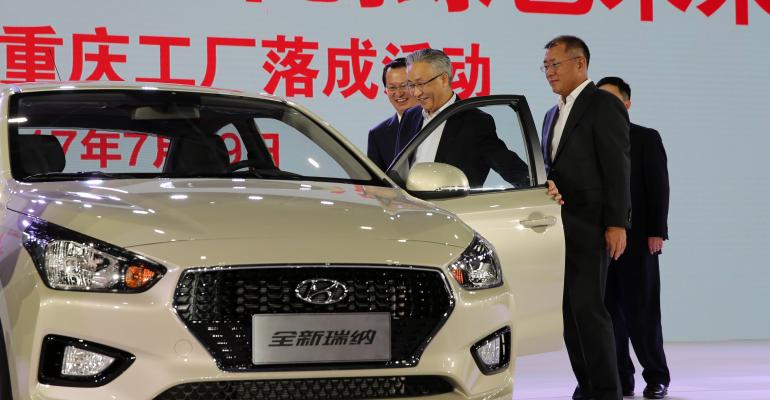Hyundai Motor Vice Chairman Chung Eui-sun meets with Chinese officials at a time when the government is tacitly encouraging a consumer boycott of Korean automobiles and other products.
Wednesday’s apparent business-as-usual meetings were arranged by moving forward the official launch celebration for Hyundai’s fifth assembly plant in China. It is located in Chongqing, about 130 miles (208 km) southwest of Beijing and gives Hyundai access to western- and central-region markets, as well continuing to serve its traditional markets in the Beijing east coastal region.
Instead of a plant launch, the event was billed as a plant-unveiling preview, with Chung touring the 300,000-vehicle-capacity plant with the mayor of Chongqing and other officials.
Before the plant tour and unveiling ceremony, the Hyundai executive met with Chen Min’er, the Chinese Peoples Central Government secretary of Chongqing, and other officials.
“The Chongqing plant, constructed as a smart and eco-friendly facility utilizing cutting-edge technologies, will produce vehicles of the highest quality for Chinese customers,” Chung says at the preview event, which also was billed as the start of the plant’s pilot production.
“We expect the new facility to contribute to Chinese government’s Belt and Road initiative and help Chongqing emerge as a new growth engine for China’s future.”
The Belt and Road initiative is a comprehensive plan to integrate all of China’s manufacturing capabilities with other nations in Europe, Asia and the Americas through sea routes in the east and land routes that follow the ancient “Silk Road” trade system that tied China to European markets for centuries. The initiative is being promoted by Chinese President Xi Jinping.
Hyundai wanted to launch the Chongqing plant three years ago. But the automaker put it on the back burner and instead began building its fourth Chinese plant in Changzhou on the east coast to meet government demands.
Hyundai already has three plants in Beijing that adequately serve the eastern coastal region, but the government wanted to develop Changzhou as a major industrial hub and would not authorize the Chongqing plant until Hyundai acquiesced. The Changzhou plant opened in October.
The 3.2 million-sq.-ft. (298,000-sq.-m) Chongqing plant is owned by Beijing Hyundai Motor Corp., a 50/50 joint venture of Hyundai and Beijing Automotive Industry Development Corp. The partnership invested $1 billion in building the facility, which gives Hyundai the improved coverage of China’s inland southwest provinces it wants as part of its strategic growth plan.
The new plant also will give Hyundai much-needed new capacity for producing SUVs. It is slated to launch two new compact SUVs and two small sedans by 2019, but the first vehicle to roll out this year will be an affordable China-specific small sedan designed primarily for young drivers.
When the two new compact SUVs are in production, BHMC will have seven SUV models in its China portfolio. Hyundai has been marketing its traditional SUV range in China but has met intense competition from new, low-cost small and compact SUVs launched by domestic Chinese automakers.
Looking at overall plans for China, Chung notes BHMC will launch six eco-friendly vehicles at its plant network in line with the Chinese government’s quest for clean mobility to improve air quality in its vastly polluted urban centers.
The rollout of eco-friendly models in the BHMC network begins later this year with an EV version of the Yuedong sedan that will be produced in Beijing. It will be followed by a plug-in hybrid-electric version of the Sonata, which also is produced in the Beijing plant complex.
The new Chongqing plant also adds to BHMC’s R&D capabilities, especially in eco-friendliness, information technology and connectivity technologies.
The Chongqing plant is slated to produce 30,000 vehicles in 2017 but will have the capacity to build a maximum 300,000 vehicles. This will increase Hyundai’s total annual capacity in China from 1.35 million to 1.65 million vehicles.
Both Hyundai and its Kia affiliate have been reeling from a consumer boycott of Korean automobiles since March. The boycott was subtly promoted by the central government to pressure South Korea into canceling the deployment of a new anti-missile system that it says upsets the global military balance in the region. The U.S.-designed system was deployed in late April.
Combined sales of BHMC and Kia’s Dongfeng Yueda Kia Motor joint venture have fallen nearly by half for the first six months of 2017, with only 429,000 vehicles sold, compared with 808,000 in first-half 2016.
June sales for Hyundai’s BHMC tumbled 64% year-on-year to 35,000 units, while Kia’s DYKM June sales dropped 62% to 17,000.





